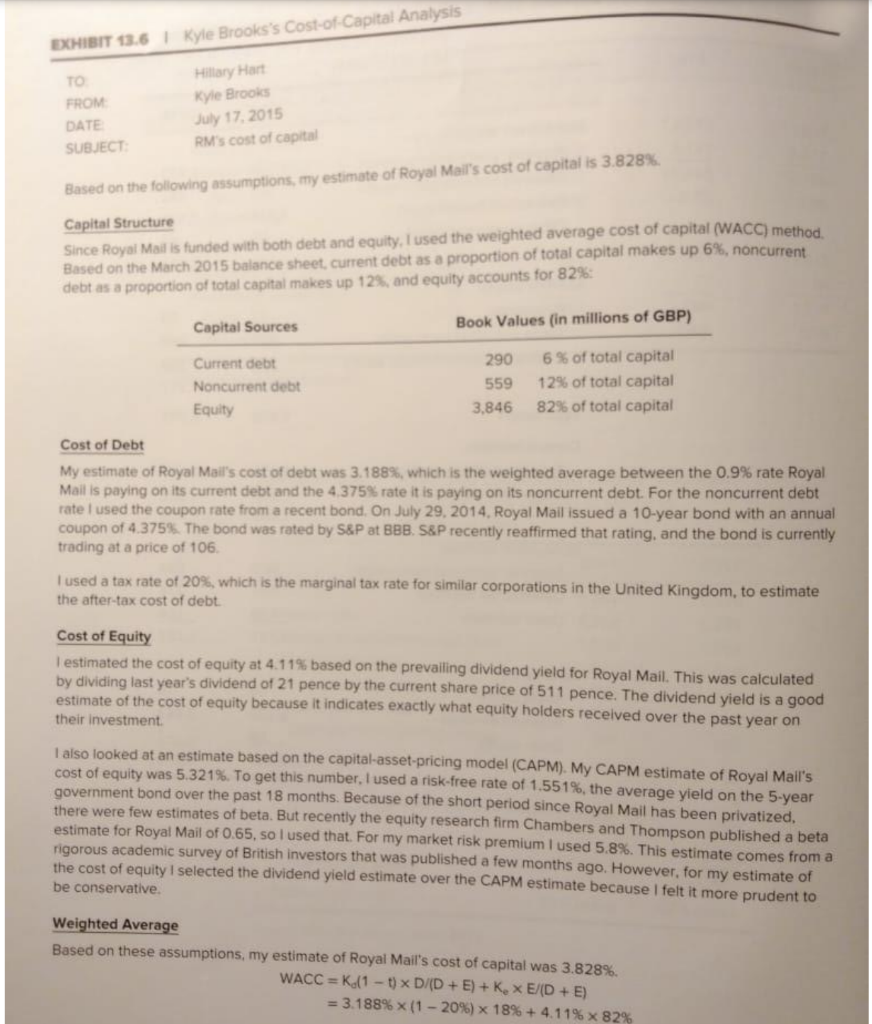Answered step by step
Verified Expert Solution
Question
1 Approved Answer
A) What is the cost of capital and why is it important? What is meant by the term weighted average cost of capital? B) do
A) What is the cost of capital and why is it important? What is meant by the term "weighted average cost of capital"?
B) do you agree with the cost of capital estimate detailed by Kyle Brooks in Exhibit 6? why or why not?
C) if you do not agree, how would you adjust the estimate?
Based on the following assumptions, my estimate of Royal Mail's cost of capital is 3.020m Capital Structure Since Royal Mail is funded with both debt and equity, I used the weighted average cost of capital (WACC) method. Based on the March 2015 balance sheet, current debt as a proportion of total capital makes up 6%, noncurrent debt as a proportion of total capital makes up 12%, and equity accounts for 82% : Cost of Debt My estimate of Royal Mail's cost of debt was 3.188\%, which is the weighted average between the 0.9% rate Royal Mail is paying on its current debt and the 4.375% rate it is paying on its noncurrent debt. For the noncurrent debt rate I used the coupon rate from a recent bond. On July 29, 2014, Royal Mail issued a 10-year bond with an annual coupon of 4.375%. The bond was rated by S\&P at B8B. S8P recently reaffirmed that rating. and the bond is currently trading at a price of 106. I used a tax rate of 20%, which is the marginal tax rate for similar corporations in the United Kingdom, to estimate the after-tax cost of debt. Cost of Equity I estimated the cost of equity at 4.11% based on the prevailing dividend yield for Royal Mail. This was calculated by dividing last year's dividend of 21 pence by the current share price of 511 pence. The dividend yield is a good estimate of the cost of equity because it indicates exactly what equity holders received over the past year on their investment. I also looked at an estimate based on the capital-asset-pricing model (CAPM). My CAPM estimate of Royal Mall's cost of equity was 5.321%. To get this number, I used a risk-free rate of 1.551%, the average yield on the 5 -year government bond over the past 18 months. Because of the short period since Royal Mail has been privatized, there were few estimates of beta. But recently the equity research firm Chambers and Thompson published a beta estimate for Royal Mail of 0.65, so I used that. For my market risk premium I used 5.8%. This estimate comes from a rigorous academic survey of British investors that was published a few months ago. However, for my estimate of the cost of equity I selected the dividend yield estimate over the CAPM estimate because I felt it more prudent to be conservative. Weighted Average Based on these assumptions, my estimate of Royal Mail's cost of capital was 3.828%. WACC=Kd(1t)D/(D+E)+KeE/(D+E)=3.188%(120%)18%+4.11%82% Based on the following assumptions, my estimate of Royal Mail's cost of capital is 3.020m Capital Structure Since Royal Mail is funded with both debt and equity, I used the weighted average cost of capital (WACC) method. Based on the March 2015 balance sheet, current debt as a proportion of total capital makes up 6%, noncurrent debt as a proportion of total capital makes up 12%, and equity accounts for 82% : Cost of Debt My estimate of Royal Mail's cost of debt was 3.188\%, which is the weighted average between the 0.9% rate Royal Mail is paying on its current debt and the 4.375% rate it is paying on its noncurrent debt. For the noncurrent debt rate I used the coupon rate from a recent bond. On July 29, 2014, Royal Mail issued a 10-year bond with an annual coupon of 4.375%. The bond was rated by S\&P at B8B. S8P recently reaffirmed that rating. and the bond is currently trading at a price of 106. I used a tax rate of 20%, which is the marginal tax rate for similar corporations in the United Kingdom, to estimate the after-tax cost of debt. Cost of Equity I estimated the cost of equity at 4.11% based on the prevailing dividend yield for Royal Mail. This was calculated by dividing last year's dividend of 21 pence by the current share price of 511 pence. The dividend yield is a good estimate of the cost of equity because it indicates exactly what equity holders received over the past year on their investment. I also looked at an estimate based on the capital-asset-pricing model (CAPM). My CAPM estimate of Royal Mall's cost of equity was 5.321%. To get this number, I used a risk-free rate of 1.551%, the average yield on the 5 -year government bond over the past 18 months. Because of the short period since Royal Mail has been privatized, there were few estimates of beta. But recently the equity research firm Chambers and Thompson published a beta estimate for Royal Mail of 0.65, so I used that. For my market risk premium I used 5.8%. This estimate comes from a rigorous academic survey of British investors that was published a few months ago. However, for my estimate of the cost of equity I selected the dividend yield estimate over the CAPM estimate because I felt it more prudent to be conservative. Weighted Average Based on these assumptions, my estimate of Royal Mail's cost of capital was 3.828%. WACC=Kd(1t)D/(D+E)+KeE/(D+E)=3.188%(120%)18%+4.11%82%
Step by Step Solution
There are 3 Steps involved in it
Step: 1

Get Instant Access to Expert-Tailored Solutions
See step-by-step solutions with expert insights and AI powered tools for academic success
Step: 2

Step: 3

Ace Your Homework with AI
Get the answers you need in no time with our AI-driven, step-by-step assistance
Get Started


